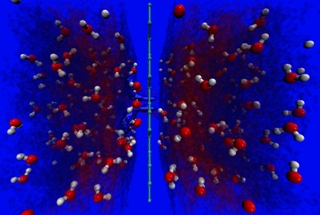Mar 18 2015
An atomically thin membrane with microscopically small holes may prove to be the basis for future hydrogen fuel cell, water filtering and desalination membranes, according to a group of 15 theorists and experimentalists, including three theoretical researchers from Penn State.
 A figure showing the proton transfer channel across a quad-defect in graphene, as obtained from a ReaxFF molecular dynamics simulation. Credit: Murali Raju, Penn State
A figure showing the proton transfer channel across a quad-defect in graphene, as obtained from a ReaxFF molecular dynamics simulation. Credit: Murali Raju, Penn State
The team, led by Franz Geiger of Northwestern University, tested the possibility of using graphene, the robust single atomic layer of carbon, as a separation membrane in water and found that naturally occurring defects, essentially a few missing carbon atoms, allowed hydrogen protons to cross the barrier at unprecedented speeds. Whereas many researchers strive to make graphene defect-free in order to exploit its superior electronic properties, Geiger’s team found that graphene required the vacancies in order to create water channels through the membrane. Computer simulations carried out at Penn State and the University of Minnesota showed the protons were shuttled across the barrier via hydroxyl-terminated atomic defects, that is, by oxygen hydrogen groups linked at the defect.
The paper, titled “Aqueous proton transfer across single-layer graphene,” will be published March 17 in the journal Nature Communications.
“Our simulations and experiments showed that you need to have at least four carbon vacancies and some sort of channel to overcome the energy barrier that would normally prevent the protons from crossing to the other side,” says Adri van Duin, associate professor of mechanical and nuclear engineering at Penn State, who used reactive force field calculations to do dynamical, atomistic scale simulations of the process. “If we can learn how to engineer the defects and the defect size, we could make an effective separation membrane. Although it still requires a lot of design work, clearly this looks highly attractive for many applications, including desalinization.”
It may also work for a new, less complicated design for fuel cells in the future, Geiger believes. “All you need is slightly imperfect single-layer graphene,” he says.
Penn State co-authors are former Ph.D. student Muralikrishna Raju, now a post-doc at Stanford, post-doc Weiwei Zhang and van Duin.
Other co-authors include Oak Ridge National Laboratory’s Raymond Unocic, Robert Sacci, Ivan Vlassiouk, Pasquale Fulvio, Panchapakesan Ganesh, David Wesolowski and Sheng Dai; Northwestern University’s Jennifer Achtyl and Geiger; and University of Virginia’s Lijun Xu, Yu Cai and Matthew Neurock (all three now at the University of Minnesota).
This work was supported by the FIRST Center, an EFRC funded by the US Department of Energy, Office of Science, Office of Basic Energy Sciences. Microscopy was conducted as part of a user proposal at the Center for Nanophase Materials Sciences, an Office of Science User Facility at ORNL.